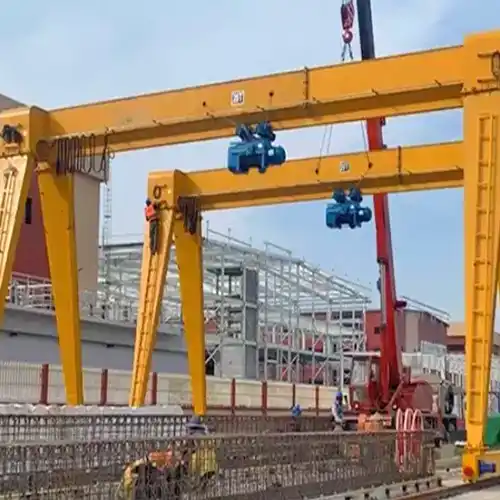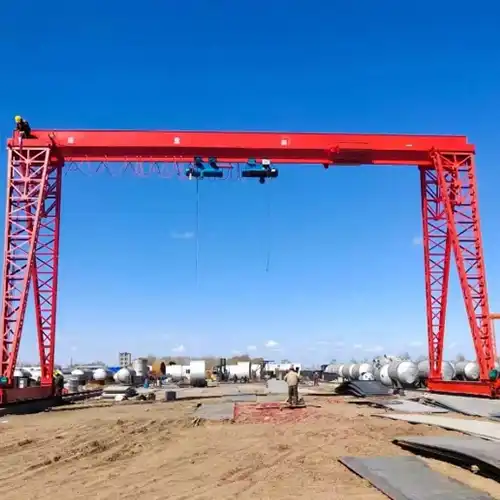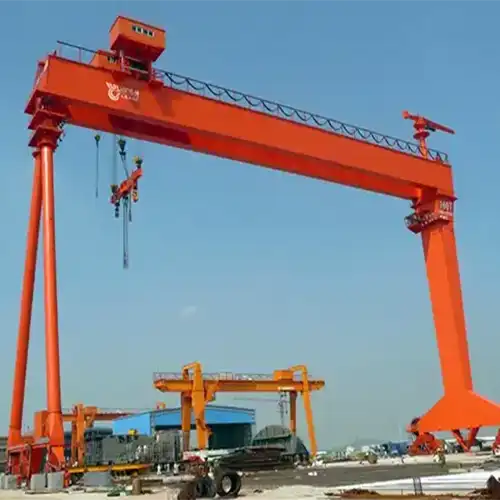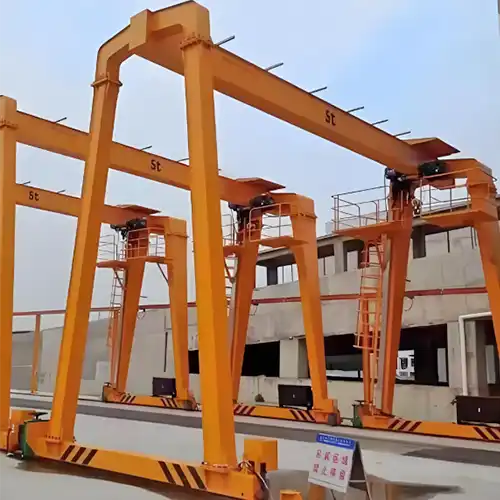Precast Concrete Handling with Synchronized Gantry Cranes
Learn practical tips for handling precast concrete safely & efficiently using synchronized gantry cranes, with advice on lifting, alignment & maintenance.
Category: Featured
Your Trusted Overhead Gantry Crane Manufacturer & Supplier
Gantry Cranes Tandem Lifting Tips and Tricks for Long Precasting Beams
Precast Concrete Handling with Synchronized 2 Sets of Gantry Cranes
Learn practical tips for handling precast concrete safely and efficiently using two synchronized gantry cranes, with advice on lifting, alignment, and maintenance.
Introduction: Challenges in Handling Precast Concrete
Moving precast concrete elements is no easy job. These panels, beams, and slabs are heavy, bulky, and sometimes irregularly shaped. One wrong move can damage the concrete, delay the project, or even create safety risks for your team.
- Large weight and awkward dimensions make lifting tricky.
- Fragile edges and corners are prone to cracking if not supported correctly.
- Manual adjustments are often limited, requiring careful equipment planning.
Why Precision and Safety Matter
Lifting large precast elements demands accuracy. Even minor misalignments can cause cracks or warping, affecting both quality and installation. Safety is equally critical. A poorly balanced lift can strain cranes, cause the load to swing, or create hazards for operators.
- Small errors can lead to expensive damage or rework.
- Uneven lifting increases stress on the crane and the concrete.
- Protecting personnel should always be the top priority.
The Advantage of Synchronized Gantry Cranes
Using two sets of synchronized gantry cranes allows both ends of a precast element to move in perfect unison. This coordination makes handling long or heavy components much safer and more precise.
- Smooth and level lifts reduce stress on the concrete.
- Operators can handle larger panels than with a single crane.
- Synchronization minimizes the risk of tilting, twisting, or sudden swings.
- Enhances overall site efficiency while maintaining safety standards.
Synchronized Gantry Crane Systems
Dual Synchronized Gantry Cranes
Dual synchronized gantry cranes are two cranes operating together as one. They are designed to lift and move large precast concrete elements safely and efficiently. By coordinating both ends of the load, these cranes prevent tilting, twisting, and uneven stress, which is essential for handling long beams, heavy slabs, or delicate panels.
Key features include:
- Both cranes lift the load simultaneously, keeping it level throughout the movement.
- Movements are synchronized to avoid tilting or twisting that could damage the concrete.
- Ideal for handling large, heavy, or fragile precast elements that are difficult with a single crane.
Precast Concrete Handling with Synchronized Gantry Cranes
The synchronization of dual cranes relies on critical components and provides advantages over single-crane systems.
Components That Make Synchronization Work
The synchronization of dual cranes relies on a few critical components. Each part plays a role in ensuring smooth, safe, and accurate lifting.
Hoists
Before lifting, it's important to understand how the hoists share the load. Proper calibration and inspection prevent uneven lifting and potential damage.
- Each crane has hoists that lift its portion of the load.
- Hoists must be calibrated to share the weight evenly.
- Regular inspection of ropes or chains ensures reliability and safety.
Control Systems
Control systems are the brain of synchronized lifting. They manage crane movements and help operators maintain precise coordination.
- Can be wired, wireless, or PLC-based depending on the project needs.
- PLC systems allow automated synchronization and real-time adjustments.
- Load monitoring features help detect imbalance before it causes problems.
Safety Interlocks
Safety interlocks act as a protective layer, preventing accidents during complex lifts. They ensure the operation stops immediately if anything goes wrong.
- Stop lifting if one crane moves faster than the other or if the load tilts.
- Protect both the concrete element and personnel on site.
- Reduce the risk of damage or accidents during lifts.
Advantages Compared to Single-Crane Systems
Using dual synchronized cranes offers clear benefits over single-crane or non-synchronized setups. Understanding these advantages helps engineers and buyers see why investing in a synchronized system is worthwhile.
- Stable lifts: Both ends move together, reducing sway and keeping the load level.
- Lower stress on concrete: Balanced lifting minimizes cracking, bending, or chipping.
- Precise placement: Elements can be positioned accurately, saving time and adjustments.
Planning and Preparation
Proper planning and preparation are essential for safe and efficient precast element handling with synchronized cranes.
Site Layout Considerations
Before moving any precast elements, the first step is checking your site. The layout can make or break the lifting operation. A clear, well-planned workspace ensures that the cranes can move safely and efficiently, and it reduces the risk of accidents.
Key points to check:
- Workshop vs. outdoor yard: Indoor workshops protect elements from weather but may have height or space limitations. Outdoor yards provide flexibility but need extra planning for ground stability and wind.
- Ground/rail alignment: Cranes need stable, level rails or tracks. Uneven surfaces can cause uneven lifting or crane stress.
- Access and clearance: Ensure there's enough space to move panels safely, including room for turning, loading, and placing elements.
Pre-Lift Calculations
Calculating the load before lifting is critical. Knowing the weight, dimensions, and balance of precast elements helps prevent accidents and material damage.
Important calculations include:
- Weight and dimensions: Verify the exact size and mass of each panel or beam to ensure the cranes can handle it.
- Load distribution and center of gravity: Understanding where the weight is concentrated helps balance the lift and avoid tilting.
- Maximum crane capacity and safety margins: Never lift near the crane's limit; always add a safety margin of 10–20% to account for unexpected shifts.
Synchronization System Setup
Even with properly placed cranes and accurate calculations, the lift will only succeed if the synchronization system is set up correctly. Taking time to calibrate and test avoids costly mistakes.
Steps to follow:
- Calibration of hoists: Adjust hoists so both ends lift evenly and stay level during movement.
- Communication between crane sets: Ensure operators can communicate clearly, using radios or control systems, and confirm that cranes respond in sync.
- Testing load movement: Before lifting the actual precast element, perform a test run with a smaller load or simulate the movement to verify smooth operation.
Operational Tips and Best Practices
Effective operational practices ensure safe, efficient, and precise handling of precast elements with synchronized cranes.
Pre-Lift Checklist
Before lifting any precast element, a thorough pre-lift check is essential. Taking a few extra minutes to inspect the cranes and verify the setup can prevent accidents and damage.
Checklist items:
- Inspect hoists, wires, and cranes: Look for wear, fraying, or any loose components that could fail under load.
- Verify synchronization signals: Ensure both cranes are communicating properly and will move in unison.
- Confirm load attachment points: Check that slings, clamps, or lifting devices are securely fastened and positioned correctly.
Lifting and Moving Techniques
Even with cranes calibrated and synchronized, the way you lift and move precast elements matters. Smooth, controlled operation reduces stress on the concrete and makes placement easier.
Practical tips:
- Simultaneous hoist operation: Both cranes should lift at the same time and speed to keep the load level.
- Adjust tension to prevent twisting or bending: Fine-tune hoist tension to match the weight distribution and avoid stressing corners or edges.
- Maintain smooth acceleration/deceleration: Avoid jerky starts or stops; sudden movements can damage the element or make it swing.
Placement and Alignment of Precast Elements
Accurate placement is critical, especially for panels, beams, or slabs that must fit into precise locations. Using proper tools and techniques makes the job faster and safer.
Key practices:
- Use guide frames or alignment tools: These help position elements without manual adjustment, reducing risk of damage.
- Avoid shock loading: Never drop or let the element settle quickly; gradual lowering protects both the concrete and the foundation.
Safety Considerations
Safety is the backbone of any precast concrete lifting operation. With dual synchronized gantry cranes, risks increase if proper precautions aren't in place. Operators need training, protocols must be established, and systems should be in place to handle unexpected conditions.
Operator Training Requirements
- Ensure operators are trained in synchronized crane operation and understand load distribution principles.
- Operators should know how to respond to misalignment, uneven lifting, or minor load swings.
- Regular refresher courses help maintain safe handling practices.
Emergency Stop Protocols
- Both cranes should have accessible emergency stop buttons.
- Operators must know the procedure to stop lifts immediately if something goes wrong.
- Establish a clear chain of command for emergency situations.
Overload and Anti-Sway Systems
- Use cranes equipped with overload protection to prevent lifting beyond capacity.
- Anti-sway devices help stabilize long panels and reduce risk of tipping or swinging.
- Regularly test these systems to ensure reliability.
Handling Unexpected Situations
- Plan for wind, uneven surfaces, or sudden obstructions.
- Adjust lift speed and hoist tension according to site conditions.
- Never attempt lifts in unsafe weather or unstable ground conditions.
Maintenance and Inspection Tips
Routine maintenance keeps synchronized gantry cranes running smoothly and prevents accidents. A proactive approach avoids downtime and protects both operators and precast elements.
Regular Checks of Synchronization Electronics
- Inspect communication links between cranes.
- Test PLC or wireless systems before each major lift.
- Replace worn sensors or control components promptly.
Hoist and Crane Structural Inspection
- Check hoists, trolley wheels, and crane girders for cracks, deformation, or wear.
- Examine wire ropes and chains for fraying or corrosion.
- Verify rail alignment and crane end stops.
Lubrication, Wire Rope, and Control System Maintenance
- Apply proper lubrication to hoist gears, rails, and moving parts.
- Clean and inspect wire ropes to avoid unexpected breakage.
- Maintain control panels and switches to prevent electrical faults.
Record-Keeping for Safety Compliance
- Document all inspections, maintenance, and repairs.
- Keep records of operator training and certifications.
- Ensure compliance with local safety regulations and standards.
Common Mistakes and How to Avoid Them
Even experienced operators can make mistakes when handling precast concrete with dual synchronized gantry cranes. Many of these errors are preventable with proper planning, attention to detail, and following best practices. Understanding common pitfalls helps improve safety, efficiency, and material quality.
Uneven Load Lifting
- Lifting one end higher than the other puts stress on the precast element and the crane.
- Always check hoist calibration and load balance before lifting.
- Use test lifts or dummy loads when handling unusually long or heavy panels.
Poor Crane Synchronization Leading to Stress on Precast Elements
- If cranes move out of sync, panels can bend, twist, or crack.
- Regularly inspect synchronization electronics and communication links.
- Train operators to monitor both ends visually and respond quickly to any imbalance.
Ignoring Small Alignment Errors
- Minor misalignments during placement can create large installation problems.
- Use guide frames, alignment tools, or adjustable supports to ensure accurate positioning.
- Don't rush the placement; take the time to verify alignment from multiple angles.
Inadequate Site Preparation
- Uneven rails, obstructed pathways, or limited clearance increase lifting risks.
- Inspect and clear the site before each lift.
- Verify ground stability, crane spacing, and access for personnel and equipment.
Conclusion
Handling precast concrete with dual synchronized gantry cranes requires careful planning, attention to detail, and well-trained operators. Following best practices can make lifts smoother, safer, and more precise, while reducing stress on both the cranes and the concrete elements.
Summary of key tips and tricks:
- Always inspect cranes, hoists, and synchronization systems before lifting.
- Plan the site layout carefully, ensuring rails are level and pathways are clear.
- Calculate load weight, distribution, and center of gravity to maintain balance.
- Use proper lifting techniques, adjust hoist tension, and maintain smooth movement.
- Communicate clearly with all team members and monitor the load from multiple angles.
- Keep up with maintenance and inspections to prevent unexpected failures.
Emphasis on safety, precision, and coordination:
- Safety should always come first—both for personnel and the concrete elements.
- Precision in lifting and placement prevents damage and ensures project quality.
- Coordination between cranes, operators, and ground staff is crucial for smooth operations.
Final recommendation:
- Invest in reliable synchronized crane systems and ensure they are regularly calibrated.
- Train operators thoroughly in dual-crane lifting procedures.
- A well-prepared team with the right equipment will handle even the largest precast elements efficiently and safely, saving time, reducing costs, and preventing accidents.
Related Products
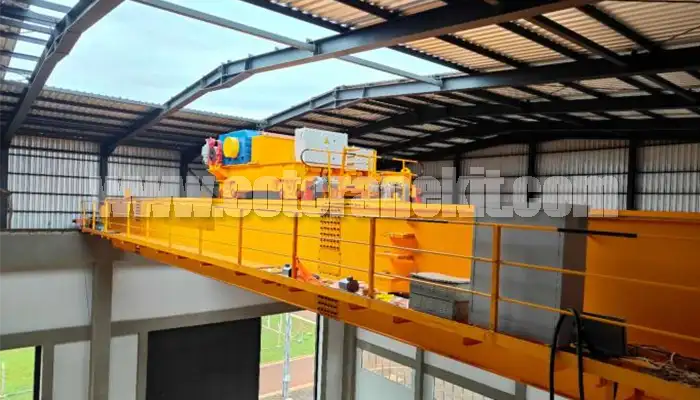
Latest project
150 Ton Overhead Crane Installation Feedback – Paraguay Case
QDX 150 ton overhead crane in action in Paraguay. Installation photos, video, and client feedback show performance, safety, and heavy-lifting efficiency.
Free consultation to Confirm Parameters & Specifications and Get
Latest Crane Price & Crane Rate.
- Types of overhead cranes : _______?
- Optional: Overhead travelling crane, goliath gantry crane,Slewing jib crane, Single girder or double girder crane,small portable crane or kbk crane, etc.
- Capacity of overhead crane: _______?
- Optional: 0.25ton, 0.5 ton, 1 ton, 2 ton, 3ton, 5 ton, 10 ton,15ton, 20ton, 25 ton, 30ton,35ton, up to 550ton, etc.
- Crane span & lifting height : _______?
- Crane travelling length : _____?
- Control of overhead crane:_______?
- Optional: pendant/ remote/cabin control
- Voltage supply of overhead crane:_____?
- Eg,: 380V50/60HZ,3Phase or others,etc.
- Application/usage of crane:_______?
- Eg,: Steel mill, ,injection mold, cement,stone, concrete,granite, general manufacturing, etc.
Just leave a message via the contact form and our hoist and crane engineer will contact you with in 24working hours.
Get In Touch
